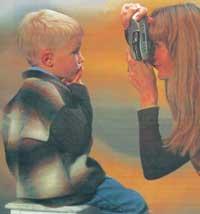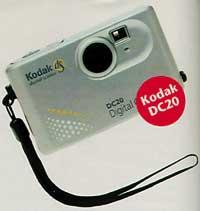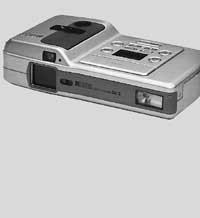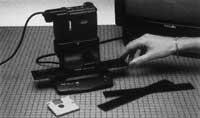Digital Cameras
1997/04/01 Otaolaurretxi, Jon Iturria: Elhuyar aldizkaria
On this subject we have already occupied Elhuyar. In the magazine Zientzia eta Teknika (see, for example, the article entitled “Numeric Photos” number 87 or article 69 “Computer Screen Photographs”). However, every day we move forward and consider it interesting to describe the current situation.
The digital photo is the one that comes out without film. The camera has sensors to transform the energy of the light rays that pass through the target into electrical energy. The image obtained is digitized point by point, compressed and saved in the internal memory of the device or on a card. By connecting the digital camera or card to the microcomputer, images can be passed to the computer hard drive. Then manipulate, deform, complete, etc. photos on the computer screen. can be performed.
Existing barriers
The main obstacles that digital cameras have faced so far have been their price and the lack of purity of the photographs taken. To reach the resolution given by the conventional 50 ISO film, digital cameras must contain 18 million pixels. Since the pixel is the definition point of the image, the more pixels it has, the higher the resolution of the image.

Some professional digital cameras, such as the DGS model or Kodak's Digital Camera System 460, offer a 6 million pixel photograph, but the price is huge and cannot be purchased by anyone. The Quicktake 100 digital camera extracted by Apple and Kodak two and a half years ago for the general public had a resolution of 300,000 pixels. Later in November 1995 Casio's QV-10 camera was released. The camera with liquid crystal display and the images taken could be seen immediately. But it was low definition and expensive (150,000 pts. or 6,000 pounds).
Advantages of digital
Although in resolution it does not reach the height of conventional cameras, the digital camera has its advantages. Allows viewing and printing on the liquid glass screen before taking the photo. In addition, the photo you do not like can be deleted immediately.
In the case of using digital cameras, it is not necessary to go to the development of the film and to take out copies as in the traditional system. Everyone can take copies on their office printer or watch them on the TV monitor whenever they want.
The lack of resolution of the images is also decreasing if the cameras that have emerged lately are analyzed. Canon's Power Shot 600 camera makes 570,000 pixel images and Olympus's 810,000 pixel Camedia C-OutloL camera.
This camera of Olympus 200,000 sts. or worth 8,000 pounds. The cheapest is the Kodak DC20 machine, with 68,000 sts. or 2,700 pounds. Note the Japanese house Sega, with 35,000 sts. or the 1400-pound digital camera.
Another advantage of these cameras is size and weight. Its dimensions are similar to those of conventional compact machines and its weight ranges from 120 to 300 grams. Optical viewfinders, zoom, macro lens, etc. are supplied. and some of these stickers have an interesting particularity. For example, to Minolta's Dimâge V device, the rotating zoom is connected to a cable of a meter in length and when there are a lot of photographers, to portray a famous character just lift your hand and zoom out above the head of others.
Another advantage of digital cameras is being able to view photos on the TV monitor. It is not necessary therefore slide projector. You can also take notes when taking the photo. PowerShot 600 machines by Can, DC-2 by Ricoh and CoolPix 300 by Nikon, for example, have the possibility to receive verbal annotations when taking each photo. The machine mentioned in Nikon also has an electronic agenda and, like in Apple's Newton, on the liquid crystal display you can write notices with an electronic pen.
Internet lovers can also send their photons through Kodak's DC20, DC25 and Nikon CoolPix 100 machines to the other end of the world.
Two trends in new machines
In this revolution of digital cameras there are two main trends. One of them requires using the microcomputer after taking photos on the camera. The camera, in a way, is the assistant of the computer. On the computer screen you can see, touch and remodel the photos.
The second trend discards the computer and connects via a cable to a special printer. This way copies of the photo are taken directly. However, they can also connect to the computer if they want to treat the images.

Camedia de Olympus is the camera of this trend. It connects directly to the specially prepared P-150E printer. It works in thermal sublimation and prints in color the A6 format in two minutes. It costs 100,000 pesetas or 4,000 pounds and each copy goes out to 125 pesetas or 5 pounds. However, the system has some errors. The camera Camedia has no zoom and also the batteries are spent a lot.
This is the second trend of Casio's QV-100 camera (112,500 sts.). or is worth 4,500 pounds). To the small QG printer - 100 which works in thermal sublimation (42,000 pts. or 1,700 pounds). Square box of 15 cm side weighs one kilo and uses self-adhesive tape cartridges to take copies of 42x55 mm (90 pcs.). or 3.5 pounds each).
The main trend is to use ultra-standard systems composed of cameras and printers. Fujifilm, for example, presents the DS7 camera with a lightweight printer called a thermo-autochrome system. Does not use ink tapes or cartridges, but special yellow paper with cyan and magenta layers (100 pts. each copy). or costs 4 pounds).
Image change programs
One of the most attractive advantages of digital photography is being able to touch and change images. The best-known programs are PhotoEnhancer (from Picture Works Technology) and PhotoDeluxe (from Adobe). They can change colors, remove defects, hide shadows left by flash, etc. Anyone can make up photos, put feet, etc. Fujifilm, for its part, has a program called “Archivist” that, in addition to the aforementioned works, allows you to connect to the Internet.
Meta Tools has the “Kai’s Powe Goo” program, which accompanies Kodak’s DC20 and DC25 machines. You can deform the image until you leave it caricature. It also offers the possibility to take out a mixed image.
However, at the moment digital cameras are more expensive than conventional cameras, but taking into account the research and progress being made in this field, it is estimated that within four years 30% of the photographic machines sold in the world will be digital.

Gai honi buruzko eduki gehiago
Elhuyarrek garatutako teknologia





